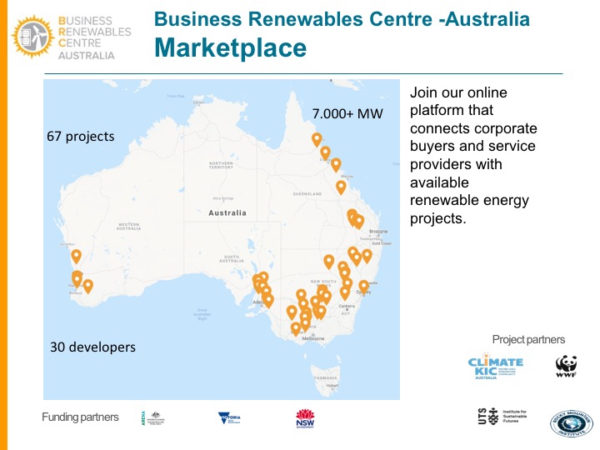It’s a little bit Tinder, a little bit covered market, but the Business Renewables Centre of Australia’s (BRC-A) independent platform for connecting corporate power purchasers with proposed renewable projects opened for business this week with 7 GW of clean energy on offer — solar and wind technologies are fairly evenly represented.
Since the launch of the Australian version of the US BRC in December last year with 60 founding members, the local team has been “working diligently to provide our members with an online portal, the marketplace and the materials they need to manage their power-purchase processes,” says Monica Richter, Program Developer with the organisation which is jointly funded by ARENA, and the Victorian and NSW governments.
The electric pool of 67 large-scale renewable projects, however, poured in from all over Australia, and the BRC-A is also state agnostic when it comes to membership, which is free.
Technical Director of the Centre, Chris Briggs says, “The 2020 Renewable Energy Target has been met, so corporate PPAs are currently the main way for new large-scale solar and wind farms to get finance.”

The BRC-A aims to accelerate and simplify corporate purchase of renewables and storage. Most company sustainability managers, said Richter at the December Smart Energy Council Summit where she previewed the service, “have traditionally purchased electricity on a one- or three-year basis; they’re not used to negotiating long-term contracts for renewable energy”.
BRC-A acknowledges the complexity of the energy market and works to mitigate the fact that there’s no such thing as a standard PPA.
The Centre’s approach to enabling corporates to negotiate the unfamiliar territory of power purchase agreements, includes providing standardised forms, and perhaps most importantly, mentorship for organisations ready to save on energy bills and take responsibility for their electricity use and emissions.
Currently, BRC-A members number around 100; they include developers, corporations and innovative retailers. A few of the names on the roll are Arup, Flow Power, Monash University, Aldi, ANZ, RES, Suncorp, Unilever, Woolworths and WePower. Some will act as mentors to members who are new to the business of renewables.
A report published by Norton Rose Fulbright in partnership with the World Wildlife Fund at the end of 2018 calculated that, “A well negotiated PPA can potentially provide savings between 15-47% on the energy component of a typical electricity bill expected in 2020.”
The key is in the negotiation, and BRC-A provides a trove of considered, easy-to-follow guides for buyers, including a Deal Structure Primer, a Risk Allocation Primer and a guide to forming a company dream team with the skill sets required to successfully complete transactions. Hands-on boot camps for buyers are scheduled to begin in May this year.
The business case for plugging into clean energy is more than financial.
Over the coming 12 to 18 months Richter says she expects to see, “a lot more ambition from companies because they’re being pressured by investors, they’re being pressured by their stakeholders; they’re also being pressured by their staff to be doing their fair share of reducing their greenhouse footprint.”
On the BRC-A’s platform, developers operate in a covered environment: confidential enough to protect sensitive information, but open for buyers to understand the characteristics of each project and initiate discussions.
Before the portal launched this week, Richter says, her team had already been connecting members desperate for advice, with others who have successfully settled into their PPA benefits.
The BRC-A’s opening goal was to facilitate 5GW of renewable energy being sold into PPAs by 2030 — “That’s about 20% of NSW load, and about 25% of Victorian load,” says the long-time campaigner for improved corporate citizenship.”
With 7GW of large-scale projects already on its books — which Briggs notes is more than 10 times the size of all large-scale renewable energy projects built last year and almost three times the capacity of projects currently under construction — that’s looking conservative.
This content is protected by copyright and may not be reused. If you want to cooperate with us and would like to reuse some of our content, please contact: editors@pv-magazine.com.









1 comment
By submitting this form you agree to pv magazine using your data for the purposes of publishing your comment.
Your personal data will only be disclosed or otherwise transmitted to third parties for the purposes of spam filtering or if this is necessary for technical maintenance of the website. Any other transfer to third parties will not take place unless this is justified on the basis of applicable data protection regulations or if pv magazine is legally obliged to do so.
You may revoke this consent at any time with effect for the future, in which case your personal data will be deleted immediately. Otherwise, your data will be deleted if pv magazine has processed your request or the purpose of data storage is fulfilled.
Further information on data privacy can be found in our Data Protection Policy.